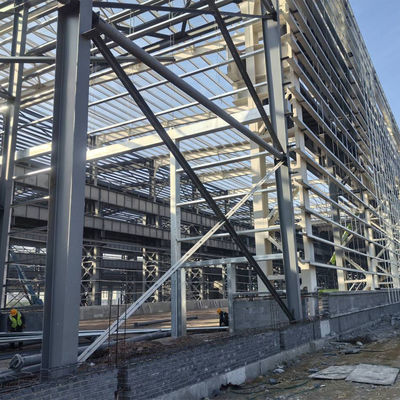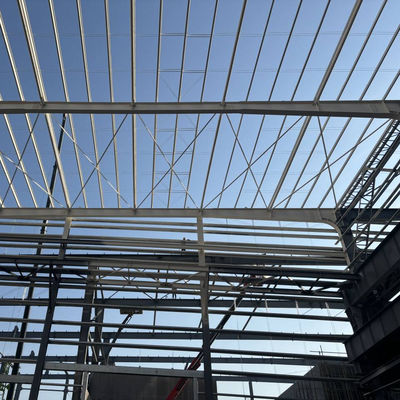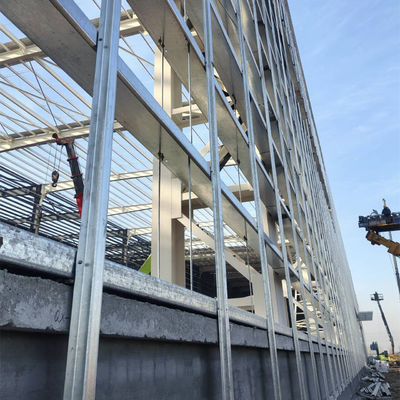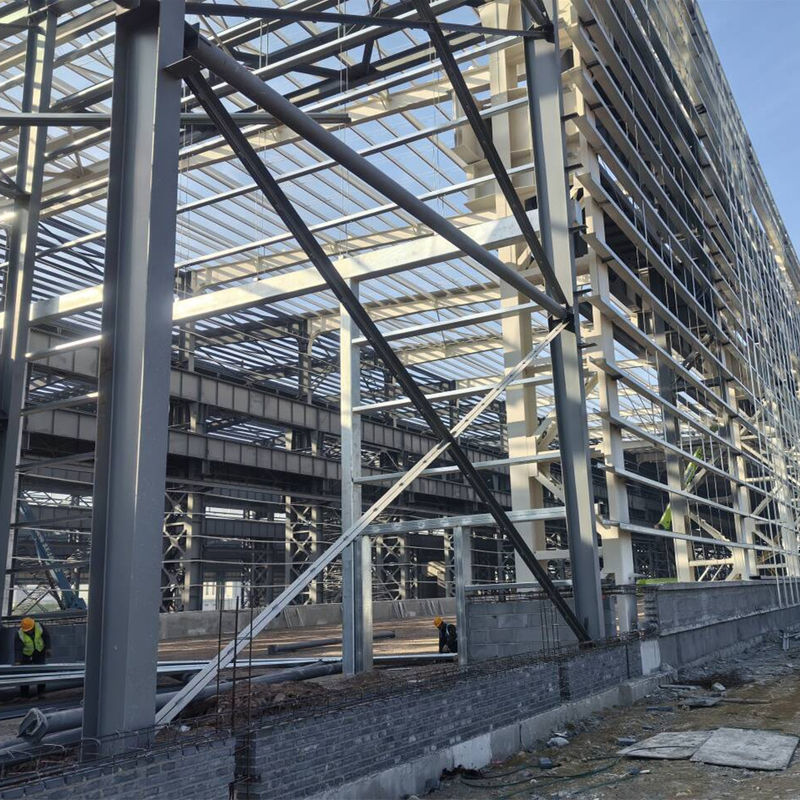Prefabricated Steel Structure Workshop Buildings with H-shaped Steel Components
Product Details:
| Place of Origin: | China |
| Brand Name: | XGZ |
| Certification: | CE, ISO, |
| Model Number: | H beam |
|
Detail Information |
|||
| Surface Treament: | Painted / Hot Dip Galvanized | Structure: | Workshop |
|---|---|---|---|
| Port: | Qingdao Tianjin | Surface Treatment: | Galvanized,Anti-corrosion Paint |
| Main Material: | Steel Structure Frames | Use: | Warehouse Workshop Hangar Garage |
| Lifespan: | More Than 50 Years | Beam: | Hot Rolled H-Section Steel |
| Frame Material: | Metal, Metal | Customization Options: | Available |
| Fabric: | Mmbrane Fabric | Reliability: | High Structural Reliability |
| Accessory: | Flashing, Skylight, Fans, Gutter | Wall Type: | Single Or Double Layer |
| Highlight: | prefabricated steel workshop buildings,H-shaped steel structure workshop,steel workshop buildings with warranty |
||
Product Description
Prefabricated Steel Structure Workshop Buildings with H-shaped Steel Components
I. H-shaped steel structure building materials
H-shaped steel is an economical and efficient type of steel with a cross-sectional shape of "H". Due to its cross-sectional characteristics (wide flanges, thin webs, and symmetrical distribution), it is widely used in the field of steel structures and is the core material for prefabricated steel structure workshops.
1. Material properties
Excellent mechanical properties: wide flange, large section modulus, strong bending and compressive resistance, suitable for withstanding large spans and heavy loads (such as factory crane beams, roof trusses, etc.).
Convenient connection: The flange is perpendicular to the web, which is convenient for bolt or welding connection. High-precision processing can be achieved during factory prefabrication, and the on-site assembly efficiency is high.
Industrial production adaptation: Standardized specifications (such as height 200-1000mm, flange width 100-400mm, etc.), suitable for mass production, with stable and controllable quality.
2. Common types
Hot-rolled H-shaped steel: Directly formed through the steel rolling process, it features precise cross-sectional dimensions and excellent mechanical properties, and is widely used in main load-bearing components (such as steel columns and steel beams).
Welded H-shaped steel: It is made by welding and splicing steel plates and can be customized to special specifications (such as non-standard height and thickness), and is used for non-standard components or local reinforcement parts.
Ii. Prefabricated steel structure factory buildings
Prefabricated steel structure workshops are a type of building that uses H-shaped steel as the main framework, combined with other prefabricated components (such as color steel plate roofs, wall panels, floor deck slabs, etc.). The main structure is processed in the factory and then transported to the site for rapid assembly.
1. Structural system composition
Main load-bearing structure:
Steel columns: Usually, hot-rolled or welded H-shaped steel is used to bear vertical loads (self-weight, equipment weight, etc.).
Steel beams: H-shaped steel beams (such as welded H-shaped steel or high-frequency welded H-shaped steel) are used for lateral load-bearing of the roof/floor and are connected to steel columns through high-strength bolts or welding to form a frame system.
Support system: It includes inter-column supports (to resist longitudinal horizontal forces) and roof supports (to ensure out-of-plane stability), and mostly uses Angle steel, round steel or H-shaped steel sections.
Enclosure structure
Roof system: Commonly used color steel plates (such as aluminized zinc color-coated steel plates) + waterproof rolls/insulation cotton, fixed with purlins (C-shaped steel or Z-shaped steel). Some factory buildings adopt profiled steel sheet composite floor deck slabs (which also serve as formwork and load-bearing layer).
Wall system: Color steel plate wall panels (with Windows and ventilation openings) or sandwich panels (with better thermal insulation and sound insulation performance), fixed to steel columns through purlins or keels.
Auxiliary system:
Basic connection: The bottom of the steel column is anchored to the concrete foundation through anchor bolts to ensure overall stability.
Door and window/equipment interfaces: Reserve interfaces for door and window openings, crane beam tracks (for heavy factory buildings), ventilation ducts, etc., to meet production requirements.
2. Application scenarios
Industrial plants: Workshops for mechanical manufacturing, automotive assembly, electronic processing, etc., require large span (24-60m), high space (8-12m), and high load-bearing capacity (crane tonnage 5-50t).
Warehousing and logistics: E-commerce warehouses, cold chain logistics centers, which require rapid construction and high space utilization.
Public buildings: stadiums, exhibition halls, and temporary emergency facilities (such as epidemic isolation wards), which need to have a short construction period and be disassemblable and reusable.
Light steel structure houses: low-rise buildings such as office buildings, dormitories, and guard booths, with lightweight enclosure materials (such as OSB boards, rock wool boards).
3. Core advantages
Short construction period: Factory prefabrication (component precision reaching millimeter level) + on-site bolt connection, which shortens the construction period by more than 50% compared to traditional concrete structures (for example, a 10,000-square-meter factory building can be completed in about 2-3 months).
Green and environmentally friendly: Steel can be 100% recycled, with less wet work on site (no large-scale concrete pouring), and low noise and dust pollution.
Economy: Standardization of components reduces material loss and lowers installation labor costs. The later renovation is flexible (such as adding or removing partition walls, adjusting the layout);
Load-bearing capacity and adaptability: The high strength of H-shaped steel can meet the requirements of large spans and heavy loads, and it has excellent seismic performance (good ductility), making it suitable for earthquake-prone areas.
Low maintenance cost: The color steel plate enclosure system is corrosion-resistant (protected by coating), has good waterproof performance, and its service life can reach more than 25 years.
Iii. Key Points of Typical Design
Fire protection design: Steel structures should be coated with fireproof coatings (thin type/thick type) or wrapped with fireproof boards to meet the fire resistance limit requirements of the "Code for Fire Protection Design of Buildings" (for example, in a factory building with a fire resistance rating of grade II, the fire resistance limit of steel columns/beams should be ≥2.5 hours /1.5 hours).
Anti-corrosion design: The surface of steel components should be hot-dip galvanized or coated with anti-corrosion paint (such as epoxy zinc-rich primer + polyurethane topcoat), and enhanced protection is required in coastal or high-humidity areas.
Node design: The beam-column connection nodes must comply with the principle of strong nodes and weak components (such as using friction-type high-strength bolts + end plates for connection) to ensure the effective transmission of force during an earthquake.
Company
![]()
![]()
![]()
![]()
![]()







